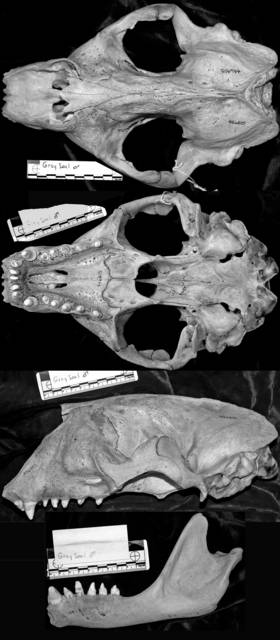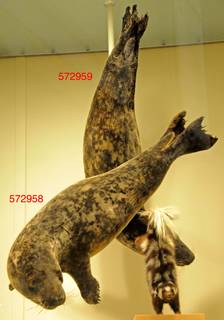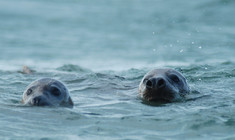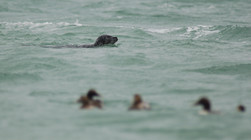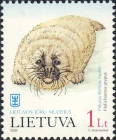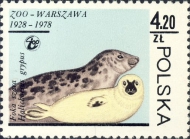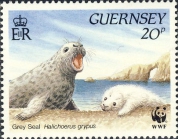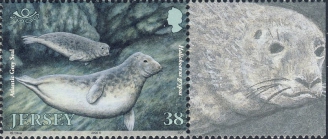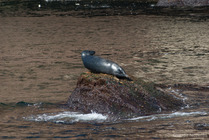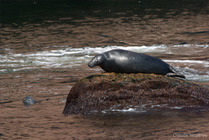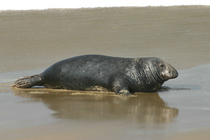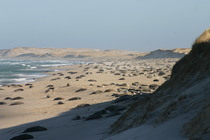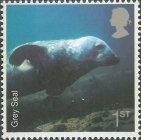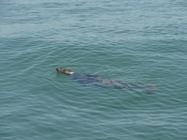
| Intro | | About | | Wiki | | Search traits | | Data explorer | | Literature | | Definitions | | Sources | | Webservices | | Statistics | | Feedback | | Editors | | Log in |
WoRMS taxon detailsHalichoerus grypus (Fabricius, 1791)
137080 (urn:lsid:marinespecies.org:taxname:137080)
accepted
Species
Phoca grypus Fabricius, 1791 · unaccepted
marine
(of Phoca grypus Fabricius, 1791) Fabricius, O. (1791). Udførlig Beskrivelse over de Grønlandske Sæle, Andet Hefte. <em>Skrivter af Naturhistorie-Selskabet.</em> 8: 73–169.
page(s): 167 (page 94 of the pdf) [details]
Distribution North America
Distribution North America [details] Distribution cold temperate to subarctic North Atlantic
Distribution cold temperate to subarctic North Atlantic [details]
WoRMS (2025). Halichoerus grypus (Fabricius, 1791). Accessed at: https://www.marinespecies.org/aphia.php?p=taxdetails&id=137080 on 2025-07-15
Date action by
Nomenclatureoriginal description
(of Phoca grypus Fabricius, 1791) Fabricius, O. (1791). Udførlig Beskrivelse over de Grønlandske Sæle, Andet Hefte. <em>Skrivter af Naturhistorie-Selskabet.</em> 8: 73–169. page(s): 167 (page 94 of the pdf) [details] basis of record van der Land, J. (2001). Tetrapoda, <B><I>in</I></B>: Costello, M.J. <i>et al.</i> (Ed.) (2001). <i>European register of marine species: a check-list of the marine species in Europe and a bibliography of guides to their identification. Collection Patrimoines Naturels,</i> 50: pp. 375-376 (look up in IMIS) [details] new combination reference Scheffer, V.B. (1958). Seals, sea lions, and walruses. <em>Stanford University Press, Stanford, California.</em> Pp. x + 179, 15 figs. (look up in IMIS) [details] Available for editors Ecologyecology source
Looby, A.; Erbe, C.; Bravo, S.; Cox, K.; Davies, H. L.; Di Iorio, L.; Jézéquel, Y.; Juanes, F.; Martin, C. W.; Mooney, T. A.; Radford, C.; Reynolds, L. K.; Rice, A. N.; Riera, A.; Rountree, R.; Spriel, B.; Stanley, J.; Vela, S.; Parsons, M. J. G. (2023). Global inventory of species categorized by known underwater sonifery. <em>Scientific Data.</em> 10(1). (look up in IMIS), available online at https://doi.org/10.1038/s41597-023-02745-4 [details] Othercontext source (BeRMS 2020)
Research Institute for Nature and Forest (INBO). European Seabirds at Sea - data collected by the Research Institute for Nature and Forest (INBO). INBO Seabird distribution data (all trips). [details]
additional source Linkletter, L. E. (1977). A checklist of marine fauna and flora of the Bay of Fundy. <em>Huntsman Marine Laboratory, St. Andrews, N.B.</em> 68: p. [details] additional source Thomas, M. L. H. (1983). Marine and coastal systems of the Quoddy Region, New Brunswick. <em>Canadian Special Publication of Fisheries and Aquatic Sciences.</em> 64:1-306. [details] Available for editors additional source Waring, G.T., J.M. Quintal and C.P. Fairfield (eds.). 2002. U.S. Atlantic and Gulf of Mexico marine mammal dtock assessments, 2002. NOAA Technical Memorandum NMFS- NE- 169. 318 p. [details] additional source Wilson, D. E.; Reeder, D. M. (1993). Mammal species of the world. <em>Smithsonian Institution Press.</em> , available online at http://vertebrates.si.edu/mammals/msw/ [details] additional source Muller, Y. (2004). Faune et flore du littoral du Nord, du Pas-de-Calais et de la Belgique: inventaire. [Coastal fauna and flora of the Nord, Pas-de-Calais and Belgium: inventory]. <em>Commission Régionale de Biologie Région Nord Pas-de-Calais: France.</em> 307 pp., available online at http://www.vliz.be/imisdocs/publications/145561.pdf [details] additional source Integrated Taxonomic Information System (ITIS). , available online at http://www.itis.gov [details] additional source Jefferson, T.A.; Leatherwood, S.; Webber, M.A. (1993). Marine mammals of the world. <em>FAO Species identification guide.</em> FAO: Rome, Italy. ISBN 92-5-103292-0. VIII, 320 pp. (look up in IMIS) [details]  Present Present  Present in aphia/obis/gbif/idigbio Present in aphia/obis/gbif/idigbio  Inaccurate Inaccurate  Introduced: alien Introduced: alien  Containing type locality Containing type locality
From regional or thematic species database
Introduced species vector dispersal in Black Sea (IHO Sea Area) : Individual release: accidental release by individuals (e.g. aquarium discards) [details]Unreviewed
Biology Grey seals breed during winter. They are less shy and more curious than the harbour seal. Young, grey seals must stay out of water until they have gained weight and moulted and for this reason they remain in a raised location for the first few weeks of their life.
Diet Fish, crustaceans, squid [details] Dimensions Length: 245 cm (8') males, 215 cm (7') females; Weight: 450 kg (990 lb males, 270 kg (600 lb) females [details] Distribution North America [details] Distribution cold temperate to subarctic North Atlantic [details] Importance They are considered pests to most fishing practices, especially herring weirs and Atlantic Salmon aquaculture sites. They are considered the primary host for the codworm. [details] Morphology Distinguishing characteristics: medium size seal, long head ("horsehead"), W-shaped nostrils, coat is mottled, female has light coat with dark spots, male has dark coart with light spots (when wet looks grey or dark). [details] Morphology Grey seal males attain 1.7 m in length and a weight of 120 kilos, whereas females are smaller reaching just 1.5 m and 90 kilos. Sexual dimorphism here is more pronounced than in any other seal species. The male is darker possessing light spots and an elongated snout. In contrast, females are lighter with darker spots. [details] Reproduction Pupping: mid December to February on rocky ledges, white coat; Weaning: 16 days followed by moult [details]
Marine Life Information Network - UK
To Barcode of Life (52 barcodes) To Biodiversity Heritage Library (317 publications) To Dyntaxa To European Nucleotide Archive, ENA (Halichoerus grypus) To GenBank (93579 nucleotides; 60548 proteins) (from synonym Phoca grypus Fabricius, 1791) To GenBank (93579 nucleotides; 60548 proteins) To Global Biotic Interactions (GloBI) To IUCN Red List (Least Concern) To NMNH Extant Collection (USNM 446405) To NMNH Extant Collection (USNM 572958 Halichoerus grypus) To PESI To ITIS |

